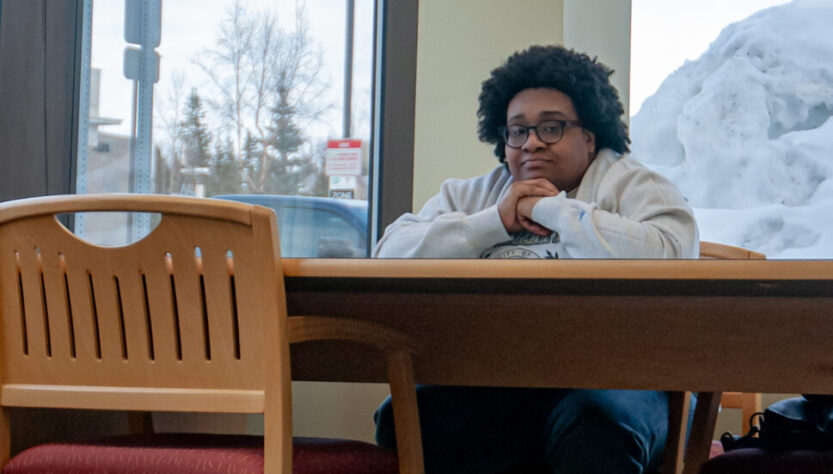Words & Photography by Raye M. White
Jennifer Spencer is very good at making herself small.
It’s not the most useful skill for a student. It doesn’t help when you’re writing a midterm paper, or taking a final exam. No professor gives out points for being invisible.
But it comes in handy when you’re living with people who could ask you to leave at any moment, people whose generosity you’re relying on because you don’t have anywhere else to stay.
Jennifer Spencer is very good at making herself small, because she had to be, during her five years of experiencing homelessness while she studied at the University of Alaska Anchorage.
Spencer’s story at UAA didn’t begin this way. She started her freshman year in 2013 as a nursing major, while living with her mother. “Your first year you’re excited. Everything’s new,” she said.
But a year later, her mother decided to leave Alaska. Spencer decided to stay.
“I just didn’t want to lose my momentum,” Spencer said. “I was just like, ‘Okay, well I guess I got to figure something out for myself.’”
Spencer called residential housing to see if she could live in the dorms, but she couldn’t afford the $300 deposit. Her next option was the Brother Francis shelter, a low-barrier emergency shelter in downtown Anchorage. Her friend drove her to the shelter, but after they arrived, she didn’t feel right leaving Spencer there.
“The environment we saw in the parking lot… she knew it wasn’t a place for a student that has to wake up tomorrow and take a test or go to class to be in,” Spencer said. “She backed up out of there.”
Her friend offered to let Spencer stay with her for a while. This was the beginning of a five-year stretch of couch-surfing for Spencer, where she stayed with friends and families for as long as their generosity lasted.
Couch-surfing is known as a type of “hidden homelessness” because people aren’t as visible as those in shelters and on the street. It’s also not recognized as a form of homelessness by the United States Department of Housing and Urban Development, which is responsible for government housing assistance programs.
According to HUD, there are four categories of homelessness: literally homeless, imminent risk of homelessness, homeless under other federal statutes, and fleeing/attempting to flee domestic violence.
Couch-surfers often don’t fall into any of these categories.
HUD defines literally homeless as someone who “lacks a fixed, regular, and adequate nighttime residence.” They mean someone who is staying in a place not meant for human habitation – a person who is sleeping in a garage, or in their car, or on the sidewalk – or someone who has been living in a shelter. They don’t mean someone like Spencer, who was staying inside of her friend’s home.
Spencer didn’t meet any of the requirements for the other HUD categories of homelessness either. She wasn’t being evicted. She didn’t qualify as a homeless youth, nor was she fleeing domestic violence. She simply didn’t have a place to call her own.
Mac Lyons, the Coordinated Entry director for the Anchorage Coalition to End Homelessness, often gets calls from people who aren’t considered homeless by HUD definitions, but still need help finding housing. He hears a lot from families who are couch-surfing, but he’s also had a few UAA students reach out to him.
Although individuals who are couch-surfing aren’t eligible for ACEH’s programs – they’re HUD-mandated – Lyons still tries to help. ACEH housing specialists can connect someone with other housing programs that help out with the first month’s rent and security deposit, or recommend affordable housing options that are available.
“We won’t be able to provide services, but we might be able to point them in the right direction,” Lyons said.
Spencer isn’t alone in experiencing housing insecurity while studying at UAA. A study done in 2017 by UAA faculty Kathi R. Trawver and Travis Hedwig found that 18% of UAA students reported that they were living in temporary housing situations, while 30% said they were not confident in being able to pay their rent on time. Additionally, 8.3% of surveyed students had experienced homelessness according to the HUD definition.
The study also looked at food insecurity, which often intersects with housing insecurity. They found that more than 44% of respondents had experienced food insecurity, which includes being worried about running out of food or skipping meals due to lack of funds.
Their results were consistent with the national averages, said Hedwig, who serves as the Assistant Dean for the Division of Population Health Sciences.
Trawver and Hedwig followed up with another survey in 2018. Though they haven’t published their study yet, Hedwig said that when they analyzed the results they found that the patterns from the previous year held.
Hedwig’s goal is to eventually gather data from campuses across the University of Alaska system. Despite the challenges – both of the previous surveys were unfunded – Hedwig believes they’re a key part in bringing awareness to the different forms housing insecurity can take.
“Homelessness conjures, in our mind’s eye visually, something different,” Hedwig said. “So my project has always been putting forth the idea that homelessness is a plurality of experiences.”
UAA wasn’t Spencer’s first experience with homelessness. When she was young, her family sometimes stayed in shelters or with extended family during rough patches. “Because I dealt with it as a child, it helped me navigate it as an adult,” she said.
She was never afraid to hit somebody up to ask if she could stay with them. “I already knew if you don’t ask, people don’t know.”
Another skill she learned as a child was how to pack light, as her family moved from place to place. As a student, she had to limit herself to two bags, because she didn’t own a vehicle or have any extra place to store her things.
“The most important things to me were my books and my clothes,” she said, “cause, I mean, you can’t come to school naked.”
She prioritized clothes that were warm enough for Alaska winters. “Good for me to be able to survive in,” she said, “if push come[s] to shove.”
Push never came to shove, but not having her own place was still uncomfortable. She always felt like she was walking on eggshells. “You never want to be asked to leave,” she said.
Sometimes she stayed with people for a few days, or a few weeks. The longest she stayed with a family was three years.
She showed her appreciation for the people who had taken the risk of housing her by always trying to contribute to the household. This kindness was inspired by her mother.
“She always did her best to give something,” Spencer said of her mother. “She always told me, ‘When you stay with folks, don’t take their kindness and squander it.’”
Giving often meant helping with chores, making sure that she didn’t take up too much space in someone’s house with her belongings, and pitching in what little cash she had.
Spencer earned some of this cash by working with Student Activities in the now-defunct Daily Den throughout the school year, and then with the New Student Orientation team during the summer. Although her student jobs didn’t pay her enough to afford rent, her job as a cook with the Daily Den—where students could get free meals each day—allowed her to eat. “I knew for a fact from Monday to Thursday I had food,” she said.
On Fridays, when the Daily Den staff would do a deep clean of the kitchen, she was able to take home food that was expiring. That food helped her get through the weekends, and ensured that the people she lived with wouldn’t have to take on the burden of feeding her.

In 2018, while working at the Daily Den, Spencer became involved in the creation of the Hunger and Homelessness Support Network at UAA. This grassroots group was started by Kojin Tranberg, who at the time was the Commuter Student Programs coordinator and in charge of the Daily Den. There had been a group of UAA employees focused on housing insecurity among students, and a group that focused on food insecurity around campus, but HHSN brought them together.
Spencer was part of both groups before HHSN was created, and remains committed to the group to this day – she currently co-chairs HHSN along with Hedwig.
One of her priorities is ending the stigma that comes with being a student and being homeless.
“Some people are like ‘Well, you can’t afford to be in school, you shouldn’t be in school,’” Spencer said. “But they’re in school because they’re following the path that we understand to get our life on track.”
Hedwig stressed the importance of having a group that works towards improving students’ access to basic needs. He’s seen some progress during his time with HHSN – there’s now a food pantry on campus, along with the Seawolves Essentials Center – but he knows there’s a lot more work to do, especially regarding how student success is defined at UAA.
“Historically, student success has been defined in academic terms,” he said. “Student success is so much more than academic success.”
Although academic success was important to Spencer, it wasn’t the only reason why she spent so many late nights at the library. She would try to stay on campus for as long as possible so she wouldn’t disturb the people she lived with.
“My whole thing was, ‘I appreciate that you’re giving me a place to sleep. I don’t want you thinking I’m taking up space in your home,’” she said.
“‘So the less that I’m here the better, the less that you have to see me the better. I don’t want to get in your way.’”
As good as Spencer was at being small, sometimes she wasn’t small enough. Sometimes she had to leave anyway.
The last time this happened, in 2018, she only had a few days to find a new place when her friend mentioned that she had a room available in her apartment. After some negotiation on the rent, Spencer moved in—finally, to a place she could call home.
Still, she had developed chronic stress from the constant insecurity, and the habits she had refined over the years were hard to break.
“I had to force myself to go home. Because I don’t have to be at the library until 2 a.m. I don’t have to be on campus until 11 p.m. I don’t have to take the last bus home. I can go home.”
Six years later, she is still going home to the same apartment with the same roommate. During that time, she has had a string of successes: graduating with her Bachelor’s of Social Work in 2019, working full-time as an academic adviser at UAA, and slowly getting used to the idea that she can take up space, in a place she won’t have to leave.
“I feel like I’m slowly coming out of it, but it’s hard,” she said. “It takes some time for you to realize like, OK, this is my space, I can call this home. No one is going to take it from me.”
True North is a publication of the University of Alaska Anchorage Department of Journalism and Public Communications. It has been published since 1995.

